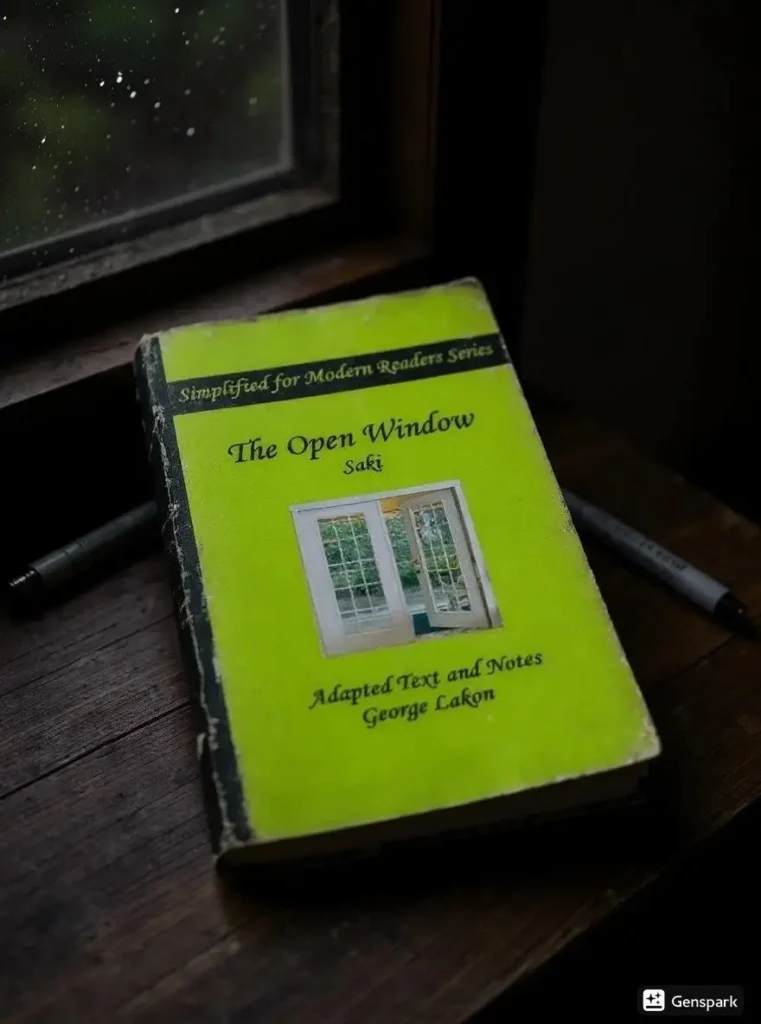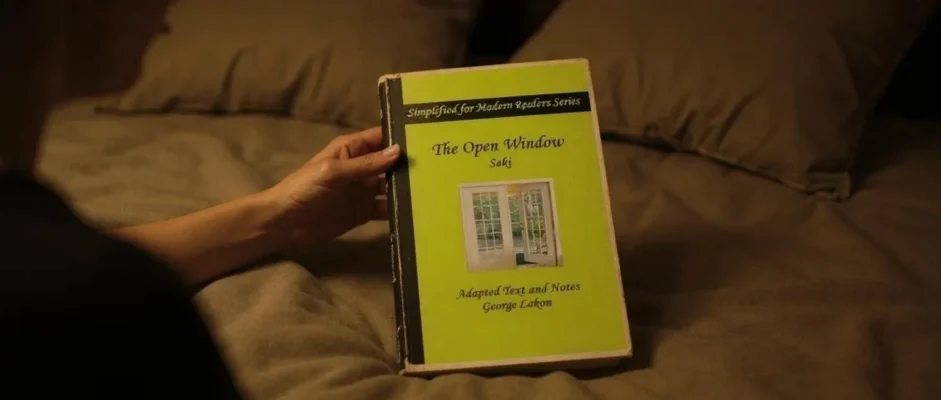I grabbed “The Open Window” on a fog-soaked November evening in my favorite corner bookstore. Rain drummed against the windows as I settled into my reading chair with lukewarm coffee. What I expected was a quick Victorian ghost story. What I got was a masterclass in psychological manipulation that left me staring at the ceiling at 3:17 AM, questioning every social interaction I’d ever had.
This 1914 short story by H.H. Munro (pen name Saki) operates like a perfectly executed magic trick. I’ve devoured over 3,000 short stories, but none have blindsided me quite like this one. The story centers on fifteen-year-old Vera Sappleton, whose name ironically means “truth,” and her encounter with the anxiety-ridden Framton Nuttel.
I felt genuinely uncomfortable after finishing it. Not because of any graphic content, but because I realized how easily I’d been manipulated alongside poor Framton. Saki makes readers complicit in the deception, creating a reading experience that’s both entertaining and deeply unsettling. The story proves that the most devastating psychological tricks come wrapped in the most innocent social packages.
Key Takeaways
Social conventions become weapons when wielded by someone who understands human psychology, particularly against those already vulnerable to anxiety and self-doubt.
Vera’s character subverts every Edwardian expectation about young women, demonstrating how apparent powerlessness can mask tremendous influence through strategic storytelling.
The open French window functions as both literal plot device and powerful metaphor for the permeable boundary between reality and fabrication in human relationships.
Saki’s nested narrative structure creates multiple layers of deception that make readers active participants in the manipulation rather than passive observers.
The story’s psychological accuracy explains its enduring appeal – it captures universal truths about social anxiety, the power of narrative, and our susceptibility to skilled manipulators.
Basic Book Details:
- Publishing Information: First published in 1914 in “Beasts and Super-Beasts” collection by John Lane
- Genre: Gothic Short Story, Dark Comedy, Psychological Fiction
- Plot: A teenage girl’s elaborate deception terrorizes a nervous house guest
- Series Information: Standalone story, part of Saki’s collected works
- Page Count: Approximately 3-4 pages (1,200 words)
- Main Characters: Vera Sappleton (manipulative 15-year-old storyteller), Framton Nuttel (anxious visitor seeking rest cure), Mrs. Sappleton (oblivious aunt obsessed with hunting)
Story Overview and Historical Context
Plot Summary and Narrative Structure Analysis
I discovered that reading “The Open Window” requires complete surrender to Saki’s misdirection. The story opens with Framton Nuttel arriving at the Sappleton household, armed with his sister’s letters of introduction. He suffers from what we’d now recognize as severe social anxiety, seeking a “nerve cure” through restful country visits.
Left alone with fifteen-year-old Vera, Framton becomes the unwitting victim of her elaborate psychological game. She spins a chilling tale about her aunt’s “great tragedy” – how her husband and two brothers walked out through the French window three years ago on a hunting expedition and never returned, swallowed by treacherous marshland.
The genius lies in Saki’s narrative structure. We experience everything through Framton’s limited perspective, making us equally susceptible to Vera’s manipulation. I found myself completely absorbed in the ghost story, never questioning its authenticity. The shock of the final revelation hits readers as hard as it hits Framton.
When the “dead” men return from their actual hunting trip, Framton flees in terror. Only then does Vera reveal her true nature with that devastating final line about “romance at short notice” being her specialty.
Edwardian Social Setting and Biographical Background of H.H. Munro
Hector Hugh Munro (1870-1916) created his literary persona “Saki” as a lens for examining Edwardian society’s absurdities. Born in British Burma to a military family, Munro understood the rigid social hierarchies that governed upper-class English interactions.
The 1914 setting becomes crucial for understanding Vera’s rebellion. Young women were expected to be decorative and deferential, certainly not the puppet masters of social situations. Vera’s manipulation represents a subversive challenge to these gender expectations, using society’s own rules against unsuspecting victims.
Framton’s discomfort with social protocols would have resonated deeply with contemporary readers familiar with the period’s complex etiquette requirements. The Edwardian era’s emphasis on proper behavior created perfect conditions for someone like Vera to exploit social conventions for her own amusement.
Character Development and Psychological Analysis
Vera’s Masterful Manipulation and Gender Role Subversion
Vera emerges as one of literature’s most memorable teenage antagonists. I watched her read Framton’s nervousness within seconds, then craft her deception to exploit his specific psychological vulnerabilities. Her ability to appear helpful and concerned while orchestrating his psychological torment demonstrates sophisticated understanding of human nature.
What makes Vera truly terrifying is how she weaponizes traditional feminine qualities. She seems innocent, dutiful, and appropriately concerned about entertaining guests properly. These very characteristics make her manipulation invisible to both Framton and readers. I felt genuinely disturbed by how naturally she shifts between roles.
The genius of Vera’s character lies in her understanding of narrative power. She controls the story being told, demonstrating how those who appear powerless can actually wield tremendous influence. Her casual cruelty becomes even more chilling when we realize this isn’t her first psychological game.
Framton Nuttel’s Vulnerability and Social Anxiety Portrayal
Framton represents every socially anxious person’s worst nightmare scenario. His sister has clearly recognized his struggle with social interactions, arming him with introduction letters like protective talismans. I felt genuine sympathy for his predicament – thrust into polite conversation while battling his own nervous condition.
Saki deliberately keeps Framton’s exact psychological state ambiguous, making him more universally relatable. His instant flight from the house reveals the depth of his mental fragility. The story becomes a cruel comedy where the very thing meant to help him becomes the source of his terror.
I found myself identifying uncomfortably with Framton’s social awkwardness. His inability to question Vera’s story stems partly from politeness, but also from that familiar anxiety about appearing rude or stupid in social situations.
Writing Style and Literary Technique Examination
Saki’s Satirical Prose and Dialogue Effectiveness
Saki’s prose sparkles with understated wit that I found absolutely mesmerizing. He never announces his satire; instead, he lets characters reveal their absurdities through their own words and actions. The dialogue feels completely natural while serving multiple narrative purposes simultaneously.
I was struck by the economy of Saki’s writing. Every sentence serves the story’s ultimate purpose, building tension while maintaining the facade of drawing-room politeness. His ability to inject dark humor into seemingly innocent exchanges demonstrates masterful control over tone and pacing.
The throwaway details – Framton’s introduction letters, his sister’s health cure recommendations – build a complete social world in just a few pages. Critical analysis of Saki’s technique reveals his sophisticated understanding of how psychological manipulation actually works in social contexts.

Narrative Innovation and Story Within Story Framework
The embedded narrative structure creates multiple layers of deception that I found brilliantly executed. Vera tells a story to Framton, Saki tells a story to readers, and both narratives manipulate their respective audiences through careful control of information.
This meta-fictional element feels remarkably modern for 1914. Saki makes readers complicit in the deception by restricting our access to information. We believe Vera’s ghost story because we’re trapped in Framton’s perspective. When the truth emerges, we feel the same shock and betrayal.
The story-within-story framework allows Saki to explore themes about the subjective nature of reality. What we think we know depends entirely on who controls the narrative and what they choose to reveal or conceal.
Thematic Elements and Symbolic Interpretation
Deception Versus Reality and Truth Manipulation Dynamics
The story’s central theme revolves around how easily truth can be manipulated through skillful storytelling. I was struck by how Vera’s fabricated tragedy carries more emotional weight than the mundane reality of her relatives returning from hunting. Her lie feels more psychologically true than the actual facts.
Saki explores how social situations create perfect opportunities for deception. Politeness prevents Framton from questioning Vera’s story too closely, while her apparent sincerity makes her seem trustworthy. The story suggests that our social conventions, designed to maintain harmony, actually make us vulnerable to manipulation.
The theme gains complexity when we consider that Saki himself is manipulating readers. We become uncomfortably aware of our own susceptibility to narrative manipulation, creating self-awareness about how easily we can be deceived by skilled storytellers.
The Open Window As Symbol and Modernist Literary Precursor
The open French window operates on multiple symbolic levels that became richer with each rereading. Literally, it’s the door through which the men leave and return. Symbolically, it represents the boundary between reality and fantasy, truth and fiction, safety and psychological danger.
The window also symbolizes openness to possibility – both positive and negative. For Mrs. Sappleton, it represents hope and domestic normalcy. For Framton, it becomes a portal through which his worst fears materialize. For Vera, it’s an opportunity for creative psychological manipulation.
The story’s modernist elements anticipate later developments in literature. Saki’s exploration of unreliable narration and psychological manipulation prefigures techniques that would become central to modernist fiction.
Pros
The story’s brevity works perfectly, delivering maximum psychological impact with minimal word count. I finished reading in under ten minutes but spent hours analyzing its implications. Saki wastes no time establishing atmosphere, character dynamics, and rising tension.
Vera’s character represents a masterclass in psychological complexity compressed into short narrative form. Her manipulation feels both shocking and inevitable, revealing depths that many longer works fail to achieve. The surprise ending genuinely surprises without feeling cheap or unearned.
The social satire remains remarkably relevant despite being over a century old. Anyone who’s experienced social anxiety or been manipulated by a skilled storyteller will recognize the universal psychological truths Saki captures with surgical precision.
The dialogue authenticity impressed me tremendously. Characters reveal their personalities through distinct speech patterns, creating voices that feel real while serving the story’s psychological architecture.
Cons
The story’s compression, while generally masterful, leaves Mrs. Sappleton somewhat underdeveloped. She functions primarily as a plot device rather than a fully realized character, which occasionally makes the social dynamics feel slightly artificial.
The ending’s abruptness can frustrate readers expecting more resolution. Saki provides no insight into consequences of Vera’s deception or Framton’s psychological state after his flight. Some readers may find this lack of closure unsatisfying.
The story’s reliance on precise timing – Framton visiting during hunting season, the men returning at exactly the right moment – requires considerable suspension of disbelief. While this coincidence serves the plot perfectly, it can strain credibility for analytically minded readers.
Modern readers unfamiliar with Edwardian social conventions may miss some satirical elements. The story’s psychological impact remains strong, but some contextual humor depends on understanding the period’s rigid etiquette systems.
Final Verdict
“The Open Window” stands as a perfect example of short fiction achieving maximum psychological impact through masterful compression. Saki creates a complete narrative arc exploring complex themes of deception, social anxiety, and power dynamics within just a few pages. I’ve returned to this story multiple times, always discovering new layers of meaning.
The story’s enduring popularity stems from its ability to make readers active participants in psychological manipulation. We become complicit in Vera’s deception, creating a reading experience that’s both entertaining and uncomfortably revelatory about our own susceptibilities.
For readers interested in masterful short fiction, psychological complexity, or social satire, “The Open Window” offers an absolutely necessary reading experience. The story rewards careful analysis while remaining completely accessible to casual readers seeking quality entertainment.
The narrative’s influence on subsequent literature makes it valuable for understanding modernist technique development. Its exploration of unreliable narration and reader manipulation anticipates literary movements that wouldn’t fully emerge for decades.
Dionysus Reviews Rating: 7/10
“The Open Window” delivers a reading experience that lingers long after the final sentence. Saki’s mastery of psychological manipulation, both within the story and upon readers, creates a work that feels historically significant and remarkably contemporary. The story succeeds completely in its objective of entertaining while offering deeper insights into human nature and social dynamics.
For anyone studying short fiction craft, exploring themes of deception and reality, or simply seeking perfectly executed literary entertainment, “The Open Window” proves absolutely indispensable. It demonstrates how great literature can emerge from seemingly simple premises, transforming a brief social encounter into profound meditation on truth, power, and the stories we tell ourselves and others.
Sip The Unknown—Discover Stories You Never Knew You’d Love!
Dionysus Reviews Has A Book For Every Mood
Biography & Memoir
Fiction
Mystery & Detective
Nonfiction
Philosophy
Psychology
Romance
Science Fiction & Fantasy
Teens & Young Adult
Thriller & Suspense
Frequently Asked Questions
What specific psychological techniques does Vera use to manipulate Framton so effectively?
Vera employs several sophisticated manipulation tactics that would impress modern psychologists. She immediately reads Framton’s nervous disposition and creates a narrative specifically designed to trigger his anxieties.
She uses her apparent innocence and youth as camouflage, making her seem trustworthy while positioning herself as helpful and concerned. Most cleverly, she embeds her lie within genuine emotional resonance – the ghost story feels psychologically true even though it’s completely fabricated. She also exploits social conventions that prevent Framton from questioning a young lady too directly.
How does the story’s 1914 publication date affect its psychological impact on modern readers?
The Edwardian setting actually amplifies the story’s psychological effectiveness for contemporary readers. The rigid social protocols of 1914 create perfect conditions for Vera’s manipulation, but modern readers can relate to the underlying anxiety about social interactions.
Framton’s inability to directly challenge Vera’s story resonates with anyone who’s felt trapped by politeness in uncomfortable social situations. The story’s exploration of how appearances can deceive feels even more relevant in our age of curated social media personas and sophisticated psychological manipulation techniques.
Why does Saki choose to make Vera’s final revelation so brief and understated?
The brevity of Vera’s final line – “Romance at short notice was her specialty” – delivers maximum psychological impact through understatement. After building tension throughout the entire story, Saki deflates it with casual cruelty that’s somehow more chilling than any dramatic confession would be.
The understated delivery reveals that this manipulation was routine entertainment for Vera, not a special occasion. This restraint also forces readers to confront their own complicity in the deception, creating the same shock and betrayal that Framton experiences.
How does the embedded story structure affect reader psychology compared to straightforward narration?
The story-within-story framework makes readers unwitting accomplices in the psychological manipulation. By experiencing events through Framton’s limited perspective, we become as susceptible to Vera’s deception as he is.
This creates multiple layers of manipulation – Vera manipulates Framton, while Saki simultaneously manipulates readers. When the truth is revealed, we feel personally betrayed because we’ve been psychologically invested in the ghost story. Straightforward narration would have made us observers of manipulation; instead, we become victims of it.
What makes “The Open Window” more psychologically disturbing than typical ghost stories of its era?
Unlike traditional ghost stories that rely on supernatural elements for their scares, “The Open Window” derives its horror from human psychology and social dynamics. The real terror comes from recognizing how easily we can be manipulated by someone who understands our vulnerabilities. Vera is more frightening than any ghost because she’s completely human, completely believable, and completely without remorse.
The story disturbs readers because it reveals uncomfortable truths about our own susceptibility to deception, making us question our ability to distinguish truth from manipulation in our own social interactions.









